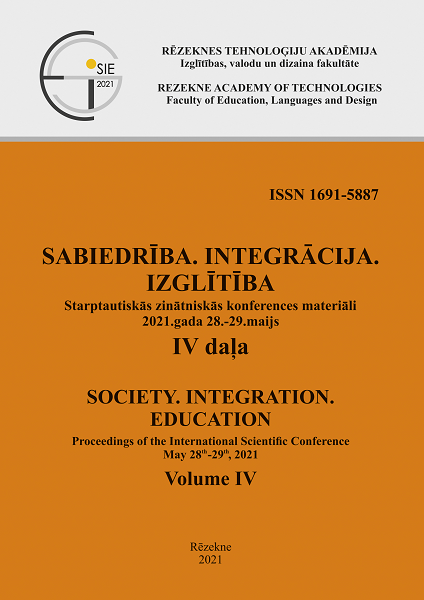MUSIC-MAKING IN A FAMILY – THE LIFELONG LEARNING TRADITIONS AND CHALLENGES OF HOME-LEARNING
DOI:
https://doi.org/10.17770/sie2021vol4.6424Keywords:
home-learning, life-long learning, folk music, music-making in familyAbstract
The aim of the present study is to compare the training of folk musical instrument play within families until 1960s in the traditional cultural environment of Latvia’s countryside to the opportunities of the same training in the early 21st century – outside the formal education but within the context of life-long learning.
Data for the research were acquired in field study, questionnaires in the virtual environment, and also the information from the Internet on the offer of music schools and institutions of non-formal education in the field of musical instrument play was used.
Until 1950s and ‘60s the basics of the musical instrument play were acquired by children within their respective families, with the musicians of the elderly generation being their tutors. The aspirations to become a musician were sparked by family traditions, the high esteem of a musician as a personality by the local community, as well as the child’s own willingness and perseverance in acquisition of an instrument’s technique. The field-study interviews show musicians always referring to past experience and family tradition, namely, some member of the family already was a musician – granddad, dad, uncle – while granny or mother have been good singers. In the cultural environment of 1960s’ countryside the two traditions – singing and music-making – are separated. The tradition of singing (both everyday and church) and its functioning in the local community was mainly sustained by the women, while playing the instruments was the part of the men.
The children started to acquire the technique of a musical instrument roughly at the age of 6–10 years, while the full status of a musician within a community could be acquired by the aspiring player as early as at the age of 16, after having played for several times at some community events (an open-air dance “zaļumballe” or an evening get-together „večerinka” in Latgale). During that period the playing skills were acquired without the ability to read score, based on musical memory.
At the end of the 20th century and the early 21st most frequently the playing skills of an instrument (like violin, clarinet or accordion) are acquired attending some institution of music education, while both children and adults have an opportunity to learn the technique of some folk instrument (zither, harmonica, little drum, etc.) within some non-formal education setting or that of an amateur group.
The present study analysis the factors either helping or hindering the continuation of the folk music- making tradition in the cultural environment of the 21st century, based on the opportunities for learning the techniques within the home-learning and life-long learning contexts.
References
Dukaļska, I. (2001-2021) Lauka pētījumu intervijas. Nepublicētie avoti. Personīgā arhīva materiāli.
Dukaļska, I. (2007). Muzicēšanas prasmju apguves iespējas bērniem 20. gadsimta 40. – 60. gados. Letonica Nr. 16. Humanitāro zinātņu zinātņu žurnāls, 27-34. Rīga: LU LFMI.
Dukaļska, I. (2014). Inovatīvie risinājumi tautas muzicēšanas atjaunošanā. Māksla un mūzika kultūras diskursā: III starptautiskās zinātniski praktiskās konferences materiāli, Rēzekne, Rēzeknes Augstskola, 107-115.
Ćalić, М., Durđanović, М. (2020). Family and its role in the cultivation and preservation of traditional folk music at junior primary school age. International Journal of Cognitive Research in Science, Engineering and Education (IJCRSEE), 8(3), 103-112 DOI: 10.23947/2334-8496-2020-8-3-103-112. Retrieved from https://ijcrsee.com/index.php/ijcrsee/article/view/500/501.
Ģimeņu skolu apvienība. (n.d.). Kas ir ģimeņu skolas. Pieejams: https://www.gimenuskoluapvieniba.lv/p/kas-ir-gimenes-skolas.html
Izglītības likums. (1998). Pieejams https: //likumi.lv/doc.php?id=50759&from=off#p8
Latvijas Nacionālais Kultūras Centrs (LNKC). (2020). Profesionālās ievirzes un profesionālās vidējās mūzikas, mākslas un dejas izglītības iestāžu kontaktinformācija. Pieejams: https://www.lnkc.gov.lv/nozares/kulturizglitiba/muzikas-un-makslas-skolu-kontaktinformacija/
Mammām un Tētiem. (2016). Savādāks viedoklis: Mājmācība – alternatīva tradicionālajam izglītības modelim Pieejams: https://www.mammamuntetiem.lv/articles/35298/savadaks-viedoklis-majmaciba--alternativa-tradicionalajam-izglitibas-modelim
Matvejeva, L. (2015). Teorija i praktika muzykal’nogo obrazovanija rebenka v sem’e. Monografija. Ekaterinburg, s. 241.
Pārdaugavas Mūzikas un mākslas skola. (n.d.). Pieejams: https://www.pmms.lv/lv/sakums/
Priekules mūzikas un mākslas skola. (n.d.). Pieejams: http://priekulemums.lv/






